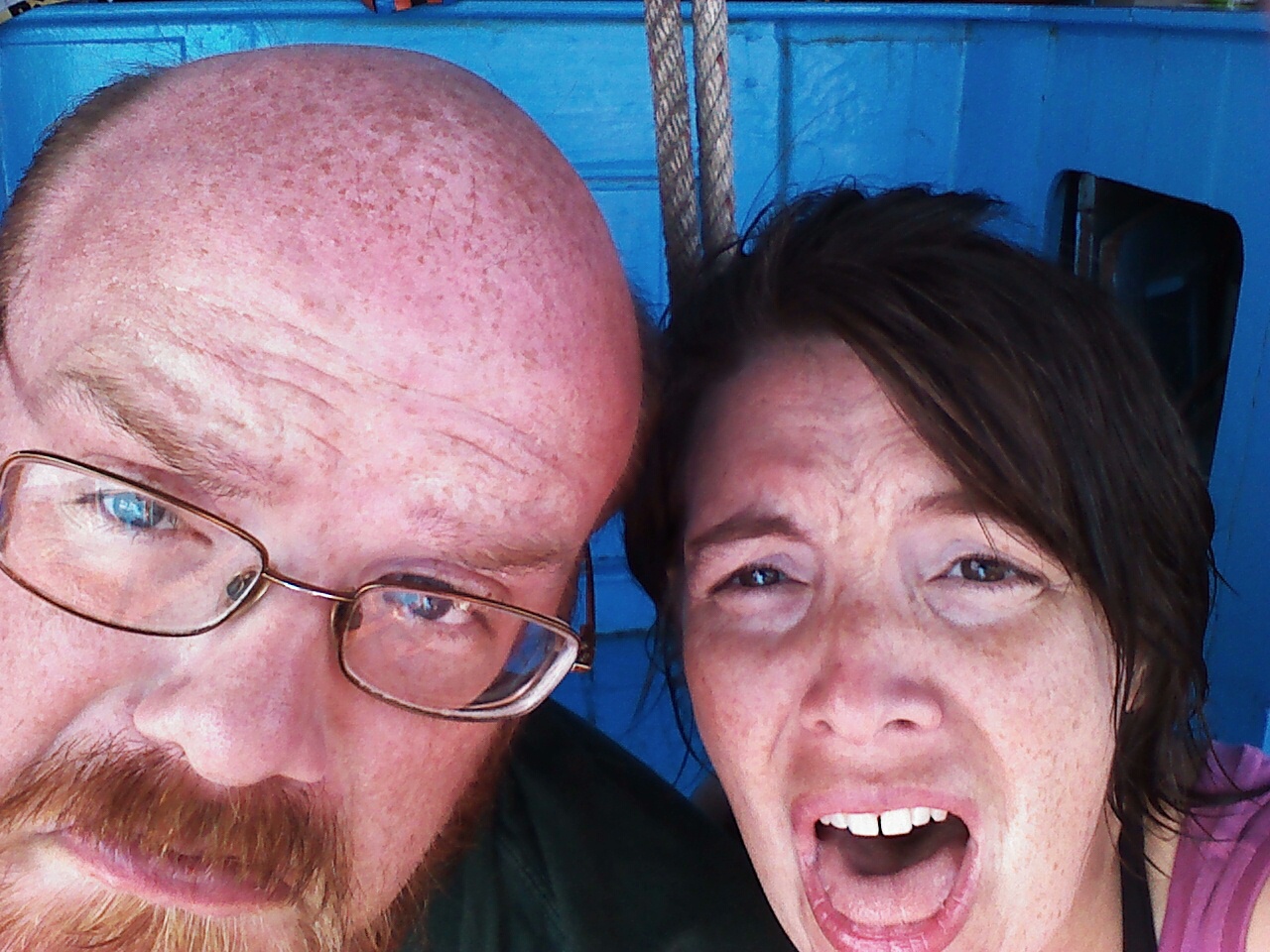Koh Tao

Thailand holds an unfair percentage of paradise. The Gulf of Thailand and Andaman Sea are scattered with tropical islands, each a glossy, magazine-spread stereotype. Like many Wisconsinites I thought aquamarine waves and powdery sand beaches were a collusion of fiction and Photoshop. They're not. And we could use a bit more of that in the Snowbelt is all I'm saying.
After my CELTA course, Sam and I headed to the islands for a well-earned break (me from coursework, Sam from putting up with me during the coursework). We chose Koh Tao, "Turtle Island," as our destination. It's reputedly one of the best places on earth to learn scuba diving. It's also a tropical island paradise. Hard to go wrong there.
GETTING THERE
Our trip to Koh Tao included a lot of "firsts," starting with our first ride on a sleeper train. On a friend's advice, we got joint train/boat tickets at Bangkok's Hua Lamphong Station. Overnight train to Chumphon, bus to the dock, ferry to the island.*
All the hype about train journeys turned out to be true: we boarded from a bustling platform in a vaulted station, our comfy chairs transformed into curtained bunks, and the rolling motion of the carriage made bathroom breaks infinitely more interesting than on a boring old plane. Win.
(Sam cautions that the bunks are snug for those over six feet tall.)
WHERE TO STAY
Ferries to Koh Tao arrive at Mae Hat, a tiny village made mostly of gift shops. The dive boats dock there, but there didn't seem to be much else going on.
We stayed in Sairee, about a mile north of Mae Hat. Sairee is the tourist hotzone. Most of the dive schools are based there, and the village is a pile-up of hotels, restaurants, and tour + laundry services. Sairee Beach is a long curve of sand between the ocean and a row of beach bars. In the evening, the bars put cushions on the sand so people can watch the sunset. That was our favorite part of the day (assuming we remembered the bug spray).
We've heard Sairee is unbearably crowded and touristy during high season.** But in October it was pleasantly empty. In the mornings I jogged along a quiet beach; in the afternoons you could count the swimmers on one hand.
Chalok Ban Kao, at the south end of the island, is quiet and languid (and, in low season, practically comatose). There are a few diving schools there, as well as some resorts and bungalows. We didn't see much of it apart from the beach.
WHAT TO DO
Really? I need to answer that? Beach!
Koh Tao was my first ocean swim without the risk of hypothermia. There are beautiful beaches all around the island where you can swim, snorkel, or lounge.
But the big draw is scuba diving. Koh Tao's vibrant marine life and crystal water make it a beautiful place to learn diving. Dozens of schools offer the PADI (open water diving) certification, as well as advanced courses for deep water, night diving, and even free diving without oxygen.
A PADI course involves several hours of basic info and safety videos, followed by three days of instruction, diving, and testing. At the end, you're certified for open water dives down to sixty feet.
They will not ask if you can swim when you sign up. Once you reach the dive site, however, you'll have to leap over the side and do a few laps around the boat, plus ten minutes treading water to prove you're up for it. After this, jumping in with a buoyancy vest and oxygen tank seems easy. Until they ask you to breathe underwater.
But swimming down into a sunlight aquarium takes your breath away in a different manner.
PADI courses run about $250 a person. (Ours was about $230 because we didn’t use their accommodation.) Most schools start courses every day, with class sizes up to 4 people. In low season, don’t bother booking in advance. Just walk around to the different schools and find one you like. We had a great experience with New Way.
WHERE TO SLEEP
Most dive schools offer free or very cheap accommodation for their students, usually in dorms or hostels. The guy at New Way, though, took one look at us old married fogeys and decided we wouldn’t enjoy bunking with all those “young polygamists.” He steered us to the guesthouse next door, where we got a fan room for 500 baht a night (about $13).
Bungalows are a lovely, basic option. I’m a little sad we didn’t stay in one. They can be very cheap, though there definitely won’t be air conditioning. There are also plenty of hotels and even a few upscale resorts around the island if you need creature comforts.
HOW TO GET AROUND
Taxis on Koh Tao are famously overpriced. Most of them are pick-up trucks, though, so it’s possible to split a fare among several travelers. The cabs aren’t metered, but the rates seem set. All the drivers have apparently agreed to work for the same (inflated) price.
Many tourists rent motorbikes. This is a good option if you’re sticking around the edges of the island. Cut across the island, and the roads become semi-vertical slaloms. Even in town, biking can be dangerous—not everyone’s a good driver. But as elsewhere in Asia, motorbikes are often the most efficient solution.
If you do rent a bike, take pictures of it before leaving the rental agency. A common scam is to charge tourists for pre-existing scratches and dings. We saw lots of people taking videos of the bikes on their phones, with the sales guy in the background, as insurance against false damage claims.
We just walked everywhere. Admittedly, it was pretty hot. But we carried lots of water, and every destination had a beach. Walking around Koh Tao was lovely, convenient, and free. Yet we appeared to be the only people doing it.
RANDOM INFO
Apparently, there aren’t any Thai people on Koh Tao. All the hotels and restaurants are staffed by Burmese workers, with impeccable English and thanakha-swirled cheeks. The dive schools are run by Westerners. The tourists all seemed to be Westerners too.
Don’t pet the centipedes (not that you were going to). Koh Tao is home to massive, poisonous, blood-red centipedes. Their bite can cause a dangerous allergic reaction in some people—everyone else would just experience sadness and pain. They’re enormous, though, and unlikely to take you by surprise.
The geckos are harmless and adorable. They like to visit hotel rooms to just to say hi and make sure you’re having a good stay.
You cannot wear enough sunscreen. I left Koh Tao with so many random burns and tan lines I looked like a calico cat.
-Erin
*The inestimably awesome Man in Seat 61 has train schedules, etc., for this trip.
**High season runs roughly February-April and July-September. But a dive instructor told us the only bad month to visit Koh Tao is December, when water visibility is low.











